Posts filed under ‘Garden History’
Wild About Wildlife Gardens
Here at Smithsonian Gardens, we’re WILD about wildlife—the birds, bees, insects, and helpful critters that contribute to our garden, community, and planet health. That’s why we’re so excited to announce our first Community of Gardens Community Collaborators, the National Wildlife Federation Garden for Wildlife program.
Continue Reading July 16, 2019 at 10:46 am smithsoniangardens Leave a comment
Harvesting Garden History, One Story at a Time

The Joseph Daniel Wilson Memorial Garden in New York City.
October is Archives Month, and as gardeners across the country harvest the last of their summer crops, we’re turning our attention to a different type of harvesting: preserving stories about gardens for future generations. Smithsonian Gardens’ Community of Gardens digital archive is celebrating Archives Month with a story-behind-the-story featuring a contributor to our digital archive.
Elizabeth Eggimann is an independent researcher in storytelling and landscape history. During her senior year at Pace University in New York City, she set out to document the untold stories of the community gardeners who have shaped the urban landscape of New York City. Tucked into formerly vacant lots and pockets of green between alleys and asphalt, these nook-and-cranny gardens are vibrant hubs of community energy and activism. Eggimann chose to interview a handful of current community gardeners rather than focus on an all-encompassing narrative of the complex history of urban community gardening in New York City. Their thoughts and wisdom form a snapshot of a city that is ever-changing in the face of development. Eggimann stresses that these oral histories were in many ways a collaborative endeavor. “The narrators are the authors of their stories,” she explains, “without their contribution, time, and generosity this project would not have been possible.”
We asked her to share her thoughts on the experience of embarking on an oral history project spotlighting gardens and gardeners. A few of the stories from her research are featured in the Community of Gardens digital archive.
How did you first become interested in community gardens?
I first became interested in community gardens when I lived adjacent to a garden in New York City’s East Village. A window in my room looked down into the garden space, which, to my delight, offered fantastic bird watching. I slowly began spending more time in the garden—having my morning cup of coffee in there or whatnot—and began feeling really grateful for the spaces presence and availability in my life. It was a retreat from the daily urban ‘hustle and bustle’ I was so accustomed to.
Where did the idea for your project come from?
I distinctly remember reading Studs Terkel’s Working: People Talk About What They Do All Day and How They Feel About What They Do. This book remains in my memory not only because I found it to be fantastic, but because of the Bertolt Brecht quote included in the preface:
“Who built the seven towers of Thebes?
The books are filled with the names of kings.
Was it kings who hauled the craggy blocks of stone? . . .
In the evening when the Chinese wall was finished
Where did the masons go? . . .”
This quote captured the thoughts that had long been stirring in my mind, and is used in the introduction of my research, Garden Memories: Oral Histories of Urban Community Gardens in New York City. The works of Studs Terkel, and New York City’s urban gardening community at large, inspired my project. The project aims to investigate the experiences of urban community gardeners in New York City. I was interested in capturing the voices behind the movement.
Do you have a favorite story or moment from your interviews?
I really enjoyed working on this project. I met amazing and generous individuals, who openly shared their stores, and for that, I am endlessly grateful. I think one of the most moving moments from my interviews was during a discussion with Haja Worley:
“We had a group of young boys from the neighborhood who would come in and do work in the garden. They worked harder than the adults did, and I would give them a little stipend, you know. The thing was to encourage them, and they would come to work almost every day. They would come to the door and say, you know, like, “are we going to the garden today?” Or they see me in the street, “are we going to the garden today?” At the time, there were dealers in the community and we wanted them to know they didn’t have to idolize these drug dealers . . . they would identify with that and wanted to emulate that without knowing the consequences. They were always willing to come and work.”
In this moment, I felt both sad and proud. From first hand experience as a New Yorker, and an American at that, I understand the realness, per se, of the phenomenon Haja is explaining, which is saddening. However, on the other hand, I felt so proud to be talking with a local community member who has taken action and generated change in lives of neighborhood children.
Why do you think it is important to preserve stories of gardens and gardening?
I feel it is important to work across disciplines to tell stories, help assign meaning to events in relation to memory, and preserve knowledge. As a feminist, I aim to interview people around their own subjectivity, exploring time itself, because, to me, that is worth something. I believe in the power of the individual narrative, and the pursuit of attempting to understand a collective history. These gardeners and gardens have, to a degree, shaped New York City’s history, and their voices and stories should not remain unheard. It’s important to preserve these stories so that we can understand how these gardens have come to exist, and what they mean to community members. In doing so, we are tracing the process of becoming.
Read Eggimann’s interviews from Garden Memories: Oral Histories of Urban Community Gardens in New York City:
- The Joseph Daniel Wilson Memorial Garden
- The William A. Harris Garden
- Albert’s Garden
- LaGuardia Corner Gardens
We rely on storytellers like YOU (both professional and newbies!) to contribute the interviews and memories that make up the fabric of the Community of Gardens digital archive. We’re truly a community of storytellers, and this is a homegrown archive.
Do gardens tell a story about your neighborhood? Anyone can share a story! Get started with our gardener oral history interview guide, or share your story at communityofgardens.si.edu. Help us preserve stories of gardens, and the gardeners who make them grow.
-Kate Fox, museum educator
October 12, 2018 at 7:45 am smithsoniangardens Leave a comment
Interview a Gardener: Smithsonian Gardens Green Ambassador Challenge

Gardeners have many stories to tell about their lives and communities. Clockwise from left to right: Four Generations of Gardeners, A Passion for Insects, Watson and Bassett, and Women in the Food Movement.
Smithsonian Gardens is excited to announce a new Community of Gardens Classroom Challenge for teens: Interview a gardener in your community and share the story with the Smithsonian!
Stories about gardens can tell us about where we’ve been and where we’re going. The beliefs we hold, scientific innovation, foodways, and cultural and community traditions are reflected back at us in the why and how of our gardens. From the Victory Gardens of World War II to community garden plots in cities and the tomatoes growing in our own backyards or balconies today, gardens are an expression of our social, cultural, artistic, and environmental values. How can documenting and sharing these garden stories in our own communities inspire others? Why is it important to save these stories for future generations?
This is a project about sharing wisdom, life experiences, and community history from a gardener’s point of view. It is also an opportunity for educators to engage teens in real-world fieldwork. Our lives are local, and investigating local stories and local voices can help students explore how they are part of a community, learn more about where they live from fellow citizens, and learn where they can do good in their own community. Storytelling is an act of sharing and participating in civic life.
By interviewing gardeners in their own community teenagers have the opportunity to connect with fellow citizens and learn more about the impact of greenspaces and gardens where they live.
Get started here or email us at communityofgardens@si.edu for more information. We welcome the opportunity to work with educators and schools from around the country!
Check out our other education resources for teens and teachers:
- Grown from the Past: A Short History of Community Gardening in the United States: Dig in and explore the history of community gardening in the United States with this digital exhibit from Smithsonian Gardens.
- Design a Green Space: Smithsonian Gardens Green Ambassador Challenge: Let Smithsonian Gardens lead you through every step of creating a school garden, from planning and designing to building.
- A Democracy of Beauty for All: Highlights from the J. Horace McFarland Collection: J. Horace McFarland was a leading proponent of the City Beautiful Movement and president of the American Civic Association. Learn about his photography from the Archives of American Gardens.
- Next Gen Gardeners: Information on the wide range of “green” career options in the world of horticulture, from garden writer to pest management to landscape architect.
- Career stories from Smithsonian Gardens: Learn firsthand what it’s like to work in a green field from Smithsonian Gardens staff. They share their journeys to public gardens from growing plants as a kid to college internships to what it’s like behind-the-scenes at the Smithsonian Institution.
-Kate Fox, Smithsonian Gardens educator
Back to School with Community of Gardens
The phrase “back to school” conjures up the crisp scent of falling leaves, the feel of a heavy backpack laden with textbooks . . . and the taste of juicy, late season tomatoes? School gardens have a long history in the United States, from their beginnings in the Progressive era to Victory Gardens during the World Wars, to the raised beds and outdoor classrooms found across schoolyards today. School gardens provide students with access to healthy and fresh food and the space to spend time outside learning about science, history, and everything in between.

School garden show hosted by the Summit Garden Club, New Jersey, circa 1900-1920. Hand-colored glass lantern slide, Archives of American Gardens.
As young people across the country head back to the classroom (if they haven’t already), here are a few school garden stories from our Community of Gardens digital archive to inspire teachers and students alike to find time to dig in the dirt and perhaps plant a seed or two this school year:

The Gardens at Chewonki in Wiscasset, Maine.
High school students, staff, and faculty tend the campus gardens and a saltwater farm with chickens, sheep, and a draft horse at this environmental organization on the coast of Maine. The farm produces 15,000 pounds of organic food each year.

Thomas Jefferson Middle School Garden in Arlington, Virginia.
The Thomas Jefferson Middle School Garden
This Virginia school garden (right in our own backyard in the Washington, D.C. metro area!) was created by a local Girl Scout troop in 2012. Today it is a community resource, playing host to classes and community events, and a portion of the produce supports the Arlington Food Assistance Center (AFAC).
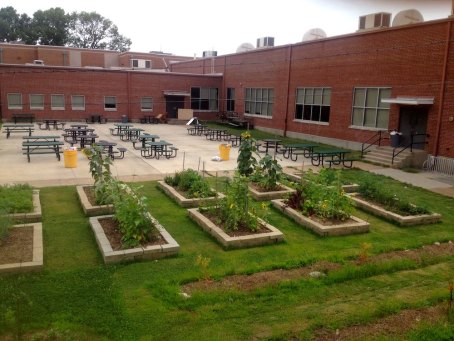
The Spartan Garden at White Station High School in Memphis, Tennessee.
The Spartan Garden at White Station High School
A committed group of high school students in Memphis built their school garden from the ground up, raising money, negotiating with school administrators for space, and building raised beds, an herb garden, and an outdoor seating area.
Teachers, grow your curriculum toolkit with these online resources from Smithsonian Gardens for learning about—and celebrating—gardens this school year:
- Grown from the Past: A Short History of Community Gardening in the United States: an online exhibit from Community of Gardens with present-day and historical images.
- Cultivating America’s Gardens: the online version of the physical exhibit now on view at the National Museum of American History, a collaboration between Smithsonian Institution Libraries, Smithsonian Gardens, and the Archives of American Gardens.
- Smithsonian Gardens Green Ambassador Garden Design Challenge: Build your own school garden or greenspace with our handy guide, and become a Smithsonian Gardens Green Ambassador.
- Community of Gardens: Does your school or club already have a school garden? Share your story with the Smithsonian Institution by contributing your story to the Community of Gardens digital archive.
-Kate Fox, Smithsonian Gardens educator
September 5, 2017 at 8:00 am smithsoniangardens Leave a comment
Transforming the Heirloom Garden into Common Ground: Our American Garden
The National Museum of American History has welcomed visitors to its doors since 1964. The landscape at the entrance consists of raised stone planters that hug the building. In the sixties, these beds were ‘green and clean,’ a mass of nondescript groundcovers. Over the years the creative vision of Smithsonian Gardens horticulturists brought a more diverse array of plantings, including a bounty of perennials and cottage garden flowers. Thus, the Heirloom Garden was born.
Opened in 1998, the Heirloom Garden highlighted plants grown in American gardens before 1950. These included old-fashioned, grandmother’s favorites and pass-along perennials like irises and blackberry lily, as well as spring-flowering bulbs like crocus, daffodils, and tulips. The garden featured plants that Thomas Jefferson grew, Dahlias that made the All-America Selection cut, and heritage roses.

Heirloom Garden, 2012
The biggest challenge turned out to be interpreting the garden. As we researched the definition of “heirloom,” we discovered no clear answer. After consulting with experts and a myriad of published resources, we found that roses, bulbs, and annuals each had to meet a different standard to be considered heirloom. Depending on the criteria, plants had to be 50, 75, or 100 years old to make the grade. Sometimes newer varieties were included, as long as they were open-pollinated (pollinated by pollinators, not by the efforts of humans). In vegetable gardening, heirloom plants such as tomatoes must be open-pollinated as opposed to hybridized (two parent plants are crossed to produce a plant with specific traits).
Try putting all that information on a sign or explaining it in a tour! We needed a new approach. How could we best share the stories of plants and their importance to people in this country? While we were reimagining the garden, curators from the National Museum of American History were researching and planning their own exhibition, Many Voices, One Nation, which asks the question, “How did we become US?” As they were nearing the end of their choices of objects and themes, the curators reached out to Smithsonian Gardens. Could we make a garden that echoed the themes of the new exhibition?

Eryngium zabelii ‘Big Blue’
The resounding answer was yes! Smithsonian Gardens staff met with museum staff to collaborate on what would become a companion garden exhibit. Eventually, we chose four themes to capture the essential connections Americans have made with plants. Plants evoke Memory through flavor, fragrance, beauty, or herbal traditional use. Likewise, many cultures in the United States use special Healing or medicinal plants. Ingenuity and Discovery rounded out the themes that define how people throughout America’s history discovered and used plants and how Americans today continue to depend on them in new ways. These themes have been translated into interpretive sign panels for the garden, now called Common Ground: Our American Garden.
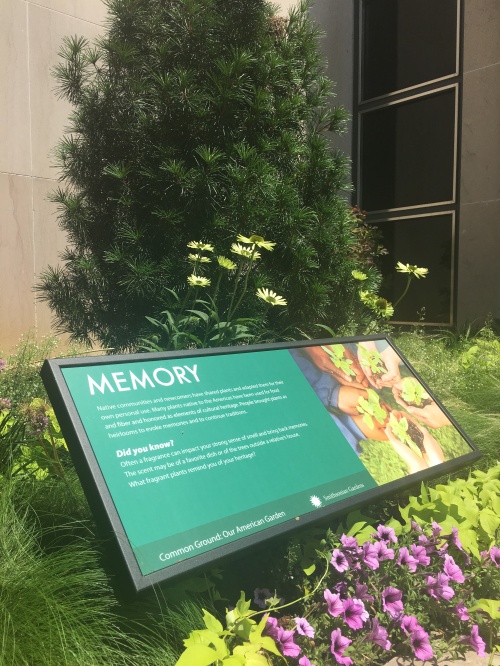
New interpretive panel for the garden.
Our gardeners and horticulturists took special care to prepare the new garden, salvaging plants from existing raised beds, scraping and removing soil around existing crape myrtle trees and replacing it with an engineered soil, as well as adding organic fertilizer and a topdressing of fine mulch. We “limbed up” or pruned 24 crapemyrtles and tucked small, shade loving “plugs” of perennials such as golden sedge, columbine, and sweet woodruff between them. We followed with over 500 Mexican feather grass and more than 1500 flowering perennials such as Echinacea (in orange, purple and green), bee balm, catmint, blanketflower, and butterflyweed.
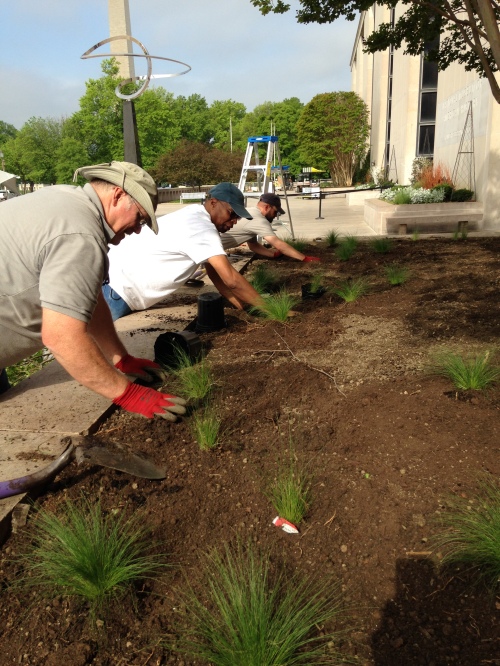
Smithsonian Gardens staff planting for the new garden.
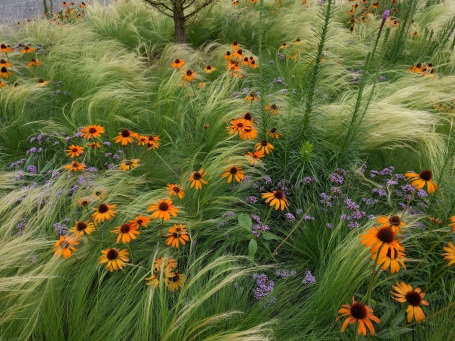
Mexican feather grass and Echinacea
The new garden is a bright stretch of raised beds with native and exotic perennials, revealing gems of useful plants and garden history along the visitor’s path. We worked to create a flowing, cohesive design. One team member brought the idea of color-blocked beds to the table, making each bed a different color. Another brought the idea of a cohesive planting mix of grasses and prairie flowers. The result is a series of orange beds punctuated by beds of blue, green and purple. Each outset bed features the same vibrant hot color while each inset bed shows a receding cool color.

Sketch for the southwest terrace, illustrating the color blocked design.
After 2 years of planning, the garden opened on June 28th in conjunction with the opening of the museum’s new wing, The Nation We Build Together, which showcases the exhibition Many Voices, One Nation. The garden now feels complete, yet it is never finished, as new seasons will continue to bring change.
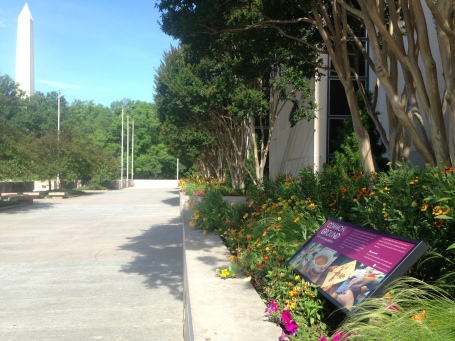
Completed garden
– Erin Clark, Smithsonian Gardens Horticulturist
Welcome to Common Ground: Our American Garden
 Completed in June 2017, Common Ground: Our American Garden is an outdoor exhibit that looks at historic and contemporary America through a plant lens. Formerly the site of the Smithsonian’s Heirloom Garden, this space features raised planting beds along the National Museum of American History’s south side facing the National Mall. The exhibit was created and installed by Smithsonian Gardens horticulturists, who worked with historians at the museum to embody themes found in the recently opened exhibition, Many Voices, One Nation.
Completed in June 2017, Common Ground: Our American Garden is an outdoor exhibit that looks at historic and contemporary America through a plant lens. Formerly the site of the Smithsonian’s Heirloom Garden, this space features raised planting beds along the National Museum of American History’s south side facing the National Mall. The exhibit was created and installed by Smithsonian Gardens horticulturists, who worked with historians at the museum to embody themes found in the recently opened exhibition, Many Voices, One Nation.
Within the colorful landscape, specific plants are highlighted based on their importance to Americans in the following ways: Memory, Healing, Discovery, and Ingenuity. Interpretive panels invite visitors to connect with their own cultural heritage, discover plants beloved for their fragrance and beauty, and enjoy a handsome vista of color befitting a museum garden in the nation’s capital.

Newly installed interpretive panels highlight the four themes of the garden.
Memory: These plants, originating from America and elsewhere, are grown to remember heritage. They provide flavor or fragrance to remind gardeners of family and home.
Healing: These plants are grown for their traditional or modern medicinal qualities. In America, entire landscapes and gardens have been cultivated to promote the health of people, especially as a respite in urban areas. New medicinal uses for plants and benefits of green spaces continue to be found today.
Discovery: These plants have been discovered, collected or documented by Americans abroad or here at home, often as part of expeditions. New discoveries continue to be made in horticulture and plant science thanks to innovative plant breeding and propagation techniques.
Ingenuity: These plants illustrate efforts by Americans to use plants in unusual ways. Some of these plant uses have grown to industrial proportions. All remain a fascinating thread in the fabric of the American garden story.

Asclepias tuberosa is both a native and a medicinal plant. One of its most interesting uses in America, however, comes from its seeds. Each seed is carried on a billowy sail of cottony fluff. Someone noticed this and utilized the fluff as stuffing for life-jackets.
Starting July 6th, twenty minute tours of Common Ground: Our American Garden will start at 9:30a.m. every Thursday through October at the National Museum of American History’s south entrance. Come and enjoy this new multi-seasonal exhibit!
Do you have memories of a garden in your community or neighborhood? Have you or someone you know grown a Victory or flower garden, or passed along plants, seeds or knowledge to family, friends and neighbors? Smithsonian Gardens invites you to share your own garden story with Community of Gardens, a collection of stories from around the nation. Stories and images can be contributed through the Community of Gardens app or at communityofgardens.si.edu
– Erin Clark, Smithsonian Gardens Horticulturist
Gardening for Good—Part I
Many of the stories in our Community of Gardens digital archive highlight the powerful impact gardening is having on urban, suburban, and rural areas around the country. Community gardening first gained popularity in the United States in the 1890s (read up on this fascinating topic in our online exhibit). For over a century community garden organizations have helped citizens learn to grow their own food, beautify their neighborhoods, and use gardens as a springboard for education and creating connections between neighbors. Right here in our own backyard in the nation’s capital, Common Good City Farm is growing fresh produce for their neighbors and teaching urban agriculture skills. And the Neighborhood Farm Initiative is teaching novice gardeners how to start and tend their own community garden plot through their Kitchen Garden Education Program. Gardens are proving to be key to providing access to fresh, healthy food in communities across the nation. Community of Gardens not only celebrates the hard work of gardening communities, but is also preserving the individual stories that make up this larger movement for future generations of gardeners and historians.
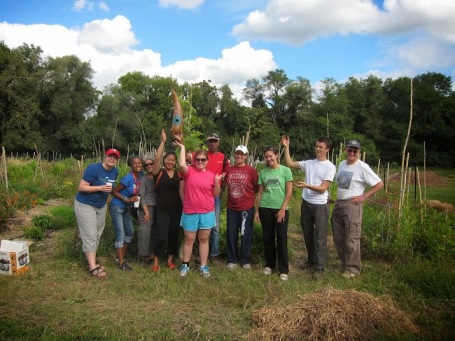
The Neighborhood Farm Initiative in Washington, D.C. offers gardening workshops for adults and families, teaching them how to plan, tend, and harvest a garden plot in their community garden.
Further afield, Grow Appalachia at Berea College in Berea, Kentucky partners with communities in six different states in the Appalachian region to provide garden grants, healthy summer meals for children in their community, and education and technical expertise for farmers and gardeners.
We recently received three stories about Grow Appalachia gardeners from Alix Burke, a AmeriCorps VISTA volunteer with the organization. She has spent almost a year collecting stories and images of gardens and gardeners in the program. The stories, ranging from a retired couple perfecting their home gardening skills to a flower farm managed by survivors of domestic abuse, are part of a verdant quilt of gardens doing good growing across the United States.
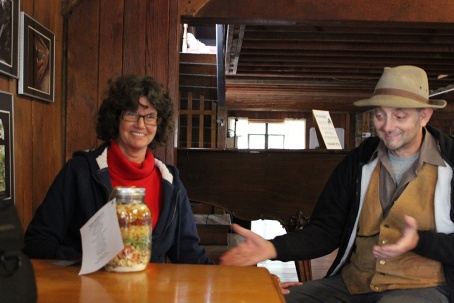
Married couple Della and Charles pose with the bounty of the harvest from their garden. They grew green beans, sweet potatoes, squash, and more. The couple expanded their home garden through the help of Grow Applaachia workshops.
Asked the importance of her work, Burke stated, “It’s important to collect these stories about Grow Appalachia gardeners and their gardens because it captures the lived realities of the program . . . from families bonding in the garden with healthier eating and exercise habits to people who are out of work turning to market gardening as a way to feed their families, both with the food they grow and with income they generate, the people and their gardens are, and always have been, the heart of Grow Appalachia.”
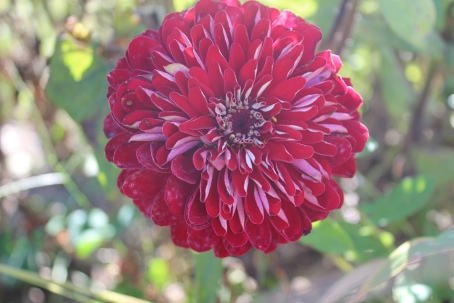
A flower grown on the Greenhouse 17 flower farm. With support from Grow Appalachia, Greenhouse 17 helps domestic abuse survivors get back on their feet and learn new job skills in horticulture and retail.
Stories about gardens can tell us about where we’ve been, and where we are going. The values and beliefs we hold, scientific innovation, foodways, and even economic trends are reflected back at us in the why and how of our gardens. What has Burke learned from her months in the field speaking to gardeners and learning about their experiences? “No one person’s experience captures what it’s like to be a Grow Appalachia gardener, but everyone’s story, in some way, contributes to the larger narrative of food security and the growing local foods economy in the region, ” she says. “Stories have always been important to the Appalachian region, from oral histories, to bluegrass lyrics, to the memories passed down with shared heirloom bean varieties. These interviews allow folks to continue a longstanding Appalachian tradition of speaking their own truths about their own lives, from the food they grow to the connections they make along the way.”
Are there gardens and gardeners doing good in your area? Encourage them to share their story with Community of Gardens! Get started here or email us at communityofgardens@si.edu.
-Kate Fox, Smithsonian Gardens educator
Smithsonian Gardens Launches New Community of Gardens Mobile App

Community of Gardens is the Smithsonian’s home for sharing garden stories.
Gardening season is here . . . flowers are just starting to peek out in the northernmost climes, and gardeners in other parts of the country are already enjoying spring peas, asparagus, and the colorful sight of tulips and daffodils. Every day, all year long, gardeners across the United States sketch plans, pore over seed catalogs, mix and lay compost, dutifully pull weeds from garden beds, build deer fencing, and tend their plants with love (and sometimes frustration with those finickier ones!). Whether you are gardening for sustenance, relaxation, health, as a creative outlet, or continuing a family or cultural tradition, there is a story behind what you do. Every gardener has a story, and those stories are important to preserve for future generations of historians, scientists, and gardeners!
Smithsonian Gardens is excited to launch its first mobile app to bring stories of gardening in the United States to life. The Community of Gardens app is the mobile companion to the Community of Gardens website, our digital archive featuring stories of everyday gardens contributed by the public.

The Community of Gardens mobile app for Apple.
Gardens past and present, big and small, can be explored from anywhere with a mobile device. From stories of community gardens to memories of grandmother’s garden roses and “putting up” jars of tomatoes, Community of Gardens is the Smithsonian’s digital home for collecting and preserving stories of gardens and the gardeners who make them grow.
Mobile users can locate stories on a map, or learn how to upload their own story about how gardening has shaped their life and community. A rich trove of writing, photographs, video, and audio bring to life the traditions and tales in our own backyards. Help the Smithsonian preserve the complexity and diversity of our garden heritage by sharing your own garden story or memory at www.communityofgardens.si.edu.
The Community of Gardens app is free is currently available for iPhone and iPad devices in the Apple app store. Don’t worry Android device users, we haven’t forgotten you! Community of Gardens will be available in the Google Play store by early summer, just in time to read and share stories of those first delicious crops of vegetables.
-Kate Fox, Smithsonian Gardens educator
Garden Inspirations: Our Latest Exhibit
Last year, I had the opportunity to design an exhibit in the Ripley Center, “Design for Small Spaces.” Featuring stumpery, fairy gardens, green walls, terrariums and dish gardens, I hoped to inspire visitors with some ideas they could try at home, even in the smallest of spaces. A favorite component of the exhibit was the fairy garden vignette. With this year’s latest installation, I wanted to delve deeper into the world of miniature gardening.
The new exhibit, “Garden Inspirations,” opened Labor Day weekend in the Ripley Center. Images from the Smithsonian’s Archives of American Gardens were used to inspire five miniature landscapes. Selecting images from the Archives was no easy task. I spent hours narrowing down options from the thousands available in that repository to find “the perfect five” to miniaturize. In my search, I was looking for images that not only documented a range of gardens, but ones I also felt confident in transforming. Which images had features I could replicate with small plants and miniature furniture and would do well in low-light conditions? Ultimately, I found five images I not only fell in love with, but met those requirements.

The Rossetti Garden, Fairfield, Conneticut. June 2013. Stacy Bass, photographer. Archives of American Gardens, Garden Club of America Collection (left). “Garden Inspirations” miniature interpretation (right).

Hicks Garden, Jacksonville, Florida. April 2010. Charles Burlingame, photographer. Archives of American Gardens, Garden Club of America Collection.

Fifth Season, Barrington, Illinois. June 2007. Eric W. Craig, photographer. Archives of American Gardens, Garden Club of America Collection (left). “Garden Inspirations” miniature interpretation (right).

The Community Garden, Millburn, New Jersey. July 2012. Lisa Gadsen, photographer. Archives of American Gardens, Garden Club of America Collection.

The Gardens at Harmony Woods, Mendocino, California. March 2012. Sandy Scott, photographer. Archives of American Gardens, Garden Club of America Collection.
I hope you’ll have a chance to visit “Garden Inspirations” and find inspiration in elements in the pictured gardens for your own plantings, as I did in the miniature displays. What colors, textures, scents, or features might you add to your own garden?
Would you like your garden to inspire other gardeners? Add images and a story about your garden to Community of Gardens, a digital home for sharing and preserving stories of gardens and the gardeners who make them grow. Anyone can add their story, which means that an account of your parents’ backyard wedding, your grandmother’s tomatoes, or your neighborhood’s community garden can become a part of the Smithsonian. Visit communityofgardens.si.edu to get started.
– Alex Thompson, Smithsonian Gardens Horticulturist
September 11, 2016 at 5:10 pm smithsoniangardens Leave a comment
A Trip Through New England Gardens
My name is Erin Clark and I’m a horticulturist with Smithsonian Gardens. Each year Smithsonian Gardens sends staff on professional development trips to gather inspiration for the gardens. Thanks to this travel grant, I was able to tour the gardens of New England. From Connecticut and the hills of Vermont to New Hampshire and Massachusetts, the vistas I experienced were vivid and the people I met were warm and welcoming. Many of the gardens I visited in the area showcased the use of plants, something we like to highlight in tours at the National Museum of American History.

Hill-Stead
I began with a selection of historic gardens in Connecticut. Starting in Hartford, I visited Hill-Stead, a home designed by an architect’s daughter for her wealthy parents in retirement, complete with a sunken garden by Beatrix Farrand. Works by Monet and other artists hang in the house and the hills outside the home used to be a working farm. I toured with Hill-Stead’s head gardener at a time when the roses bloomed in top form.

Landscape Historian Sheila Wertheimer of the Florence Griswold Museum
At The Florence Griswold Museum I spoke with Landscape Historian Sheila Wertheimer who works with volunteers to ensure that the grounds are beautiful and accurate to their original aesthetic. Sheila enlisted the help of an archaeologist to find the original bed locations. Referencing old photographs and paintings by the artists that flocked to this boarding house turned artists’ colony, she recreated a colonial revival garden, complete with roses, yarrow, and delphiniums. The site now hosts an art gallery and a cafe overlooking the Lieutenant River.

View of the gardens and barn at The Florence Griswold Museum.
In Massachusetts I visited the campus of Smith College, toured the greenhouse there, and enjoyed the synoptic beds laid out by plant family. Near Massachusetts’ northern border is a place called the Bridge of Flowers where a footbridge stretches across the Deerfield River, adorned in cottage garden flowers and trees reminiscent of Monet’s garden in France.

Me, about to cross the Bridge of Flowers

Bridge of Flowers
Next I drove to Tasha Tudor’s Garden in Marlboro, VT. There the famous children’s book illustrator lived a quiet life in a house built by her son. The Tudor family leads a few tours each year and still keeps the house much as the artist did during her lifetime. An entire field of lupine greeted visitors at the gate. The garden’s crab apples and daffodils had long since bloomed, giving way to the exuberance of summer. Tasha’s grandson, Winslow, proudly showed us the gardens and chickens. Seth Tudor, Tasha’s son, showed us the beams of the house he built by hand and the tiny puppet studio that the family used to entertain neighborhood children.

Amy Tudor (right) and I (left)
Tasha Tudor, born in 1915, had a love of the old way of doing things, and kept goats, churned butter and gardened, all in late 19th century style dress. There are still notes on the wall with phone numbers, important dates and weather conditions, and sketches of her beloved corgis. A testament to her love of the artistic process, she chose weaving over modern pastimes like watching television and kept two looms that dwarfed the rooms they occupied. Staying there in Vermont among lakes and evergreens, watching the water birds and the sunset, I could understand why Tasha had chosen this place.

Meeting place for the Tasha Tudor Garden in Marlboro, VT. The cottage garden, with sweeps of lupine and crabapple, is nestled in the forest. Lupine (right) lines a Vermont roadside.
I was off to Portsmouth, New Hampshire the next day, and explored the preserved town of Strawbery Banke (named in the English of the day). It was named for the wild strawberries that grew along the banks, enough to fill the hull of a ship. Several houses and backyard gardens illustrate this site’s 400-year-old history. Erik Wochholz, the Curator of Historic Landscapes at the Strawbery Banke Museum, led me on a tour and we sampled our way through herbs used for brewing and as garnishes. Kids have an opportunity to wander through colonial gardens, explore a WWII-era store, and even do a paleobotany activity examining modern pollen under microscope.

Herb Garden at Strawbery Banke Museum
John Forti, the Massachusetts Horticultural Society’s Director of Horticulture and Education, met with me for my last stop before heading back to D.C. MHS owns a historic estate next to a soccer park, complete with a grotto, a formal garden and several themed gardens. During the last year, wooden structures and arches have been built and educational interpretation for youth has grown. The veggie garden, next to a peaked frame house built by the monks who once ran the site, is the current domain of several heirloom lettuces, tomatoes, and strawberries, as well as a nesting killdeer.
Heading into the city and to the airport, I was left with beautiful memories of the places I had visited on this whirlwind tour. I learned about the importance plants have in providing a sense of place in a garden. I saw many different ways of interpreting history with labeling, programs and art. Every place has a different focus, a different plant palette, and a set of people who love it, dedicated to its continuance, much like Smithsonian Gardens.
– Erin Clark, Smithsonian Gardens Horticulturist
August 22, 2016 at 2:38 pm smithsoniangardens Leave a comment
